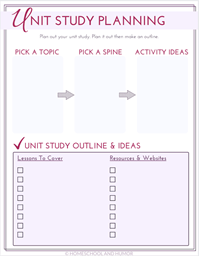It’s a fabulous feeling to start your day off knowing exactly what you’re going to do that day in homeschool. This is what lesson planning is all about. Preparation. And getting rid of the stress and anxiety.
One of the most challenging things in homeschool is figuring out how to design your lessons. And make your lesson plans. Well, it was the most challenging for me. If you’re struggling with this too, I’ve gathered a few tips for how to make simple lesson plans. These tips will help push you through this thought-provoking area.

Quick Lesson Planning Tips
Before you do anything, get a binder. You can add a planner here or use your current way to plan, such as digital or software, but either way, you need a homeschool mom binder to store specific contents. You’ll be putting all your information in this bad boy, even your notes, when preparing your lesson plans.
And before I dive into lesson planning tips, here’s the simplest way of all: Save yourself some time and buy a curriculum that has the lesson plan with it. When you do this, you know exactly how much you are supposed to accomplish every day. You won’t have any preparation to do other than glancing over the lessons and knowing what you’ll be covering each day and week.
But if you can’t afford a particular program with lesson plans included or you just don’t find one that you like, try to find a curriculum that is simple to divide up throughout the year and do daily. One that’s very homeschool-friendly to use.
For example, when I say homeschool-friendly to use, I mean this: Our elementary science book we’re doing as a family has quick, concise lessons that are short enough to do in a day. That’s real easy for me. If I wish to extend it or dive deeper, I will find a video or a book that furthers their learning on the topic. Since we do science two days a week, we’ll get two lessons done each week, and that’s perfect for our family. Easy and simple.
You could also find curricula that’s easy enough just doing one page a lesson. Perhaps a lesson has multiple pages in it. You could just do one page a day and that’s all. The more user-friendly the curriculum like this is – meaning the simpler you can make planning out your year using this curriculum – the easier the lesson plans are going to be.
And if you want to add in some hands-on projects to correspond with your lesson plans, you’ll have time to add those in since your lesson didn’t take up a ton of time. Besides, the younger the child, the shorter the lessons are going to be due to their learning development and attention spans. I’m talking 10 minutes for a lesson and no longer than 20-30 minutes ever. Anything longer than this is information overload and your kid will burn out quickly.

Making Lesson Plans Using A Textbook
Sometimes you’ll come across a public school textbook that’s actually really great to use in your homeschool. Or you’ll find one in a thrift store with current information and in fabulous condition and with inviting information you know your kids will enjoy.
To make lesson plans using a textbook, you need to do a little math to figure out how many pages in a day or a week you want to do. Follow these steps to make lesson plans with a textbook:
- Decide how many weeks you plan to homeschool. Usually, most families do 36 weeks.
- How many projects do you want to add in throughout the year? This will affect your lessons and you need to account for the time you allot to project days.
- Step 1 minus Step 2 is how many weeks total you’ll have for regular lessons. You subtract out the project days/weeks from your total for accuracy in later steps.
- Next, take your textbook. How many pages are in your textbook?
- Find how many lessons or chapters are in the textbook.
- How many pages of tests/reviews are in the book?
- Step 5 minus Step 6 will get you the total number of real pages and you won’t be counting the tests/reviews pages.
- Lastly, divide Step 7 Answer by Step 3 Answer. This will give you how many pages to do per week.

Putting Your Steps Together For Your Lessons
Once you have this information, put this in your homeschool. Then grab your textbook and your binder, and you’re ready to make your lesson plans for the year. You can also be done at this point and just divide the contents of the textbook over the number of school weeks.
You could also take a step back and look at it from a big-picture view. If you do 36 weeks of school and your textbook has, say, 25 chapters in it, you can easily do just one chapter a week. Then divide the number of pages in each chapter to determine how many pages you’ll cover per day during that week.
The bottom line is you are either going to spend the money or the time it’s your choice. When you write out your lesson plan make sure that you list the contents and pages you’ll do each day. Usually, homeschoolers have things come up throughout the year unexpectedly, so I wouldn’t date any of the lessons unless you want to.
However, you could just date a month’s worth of lessons at a time, or write tentative dates for the lessons, so you know what to expect and where to fit in other things for that day.
It also might be handy to write down what you did for that day after your lesson is completed. This will also keep you on track for future lessons, knowing what you actually did versus what you wanted to do. Very rarely do our days go exactly as we want them to!

Bonus Section: Unit Study Planning
Unit Studies are also a great way to make lesson plans. They can fill in the gaps where you don’t have any lessons for a time period. They also let your kids dive deeper into a subject. Not only these reasons but one more good reason to use unit studies is this: these can be your lesson plans! You won’t have to purchase a curriculum if you gather information to create your own unit studies for a particular topic!
Think history or science, for example, for unit study creation. You can take any topic in history or science that you want to cover for the year and make a unit study out of it. This way you don’t have to purchase a curriculum that covers that topic, saving you both money and time.
The three simple steps to making unit studies are:
- Take a topic or concept and make that the basis of the unit study.
Choose a topic as your focal point. This is the main thing you will study and learn [more] about. - Find a spine for the unit study. It will direct all your lessons.
The spine is a book that acts as the vehicle to create your lessons and activities. But your spine doesn’t have to be a book; it could be a play, a concert, a workbook, an encyclopedia, a chapter book, a movie, and so on. Whatever you choose, it is what will influence your lessons throughout the study. - Plan your lessons and activities around the spine.
Doing this will create your entire unit study! You can search through teacher websites, TeachersPayTeachers shops, Etsy, and free homeschool resource sites to find and gather a cumulative stack of resources to use throughout the unit study, depending on the certain topics you’re going over.

How To Make Lesson Plans From A Textbook
So get a notebook to write your notes on with all your lessons. Create your lesson plans. Or buy a curriculum with lesson plans already made for it. This is the simplest approach to lesson planning. Of course, there are other ways to create lessons. And not everything is a textbook! You have workbooks, digital curriculums, and guides to break down and form your lesson plans. In any of these cases, just follow the steps as closely as you can up above, and you’ll be golden for the year.
—oOo—

A huge thank you to Richie Soares with Homeschool and Humor for this article.
You can find Richie on Facebook, Instagram, Pinterest, and YouTube!
